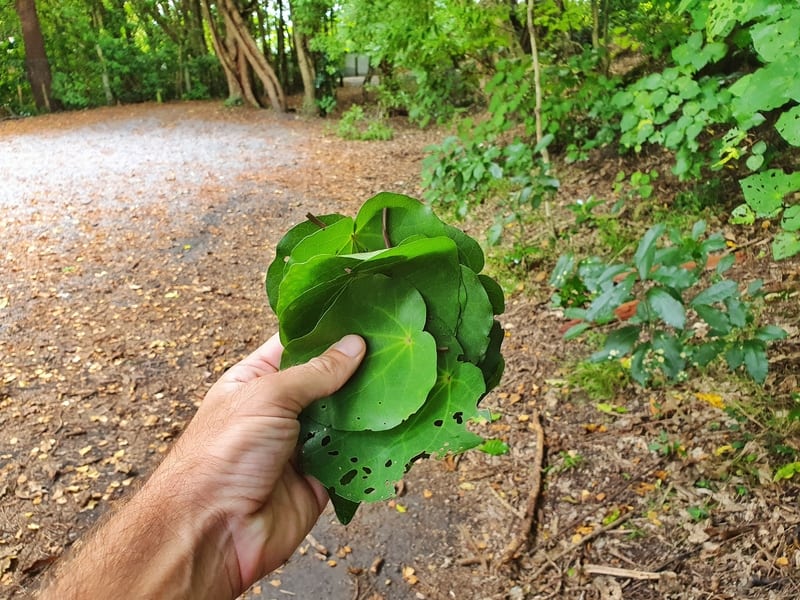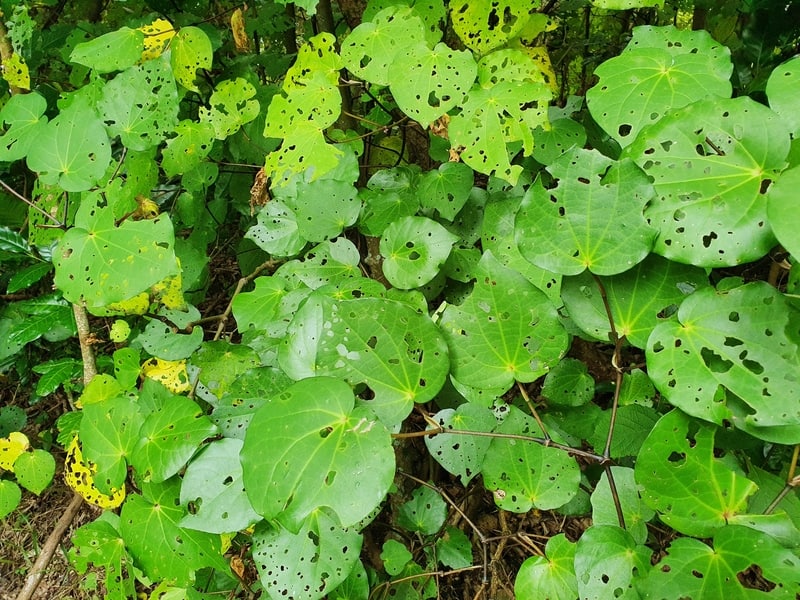If you’ve read other Kawakawa tea recipes, this method isn’t anything new. But here’s a fun story about kawakawa you can tell your tea-drinking friends and family.
As a good luck charm, Maori would place a sprig of kawakawa under the bed when they were having sex with the plan to conceive. This makes the kawakawa tree an important tree for Maori families at all stages of their life.
Next up is the recipe, what you’re here for. But continue reading beyond the recipe to learn more about the kawakawa plant, including which leaves are the best to harvest.
1. GIVE ME THE RECIPE
2. Tips for harvesting leaves
3. Benefits of kawakawa tea
4. Fun facts about kawakawa
5. Resources
HOW TO MAKE KAWAKAWA TEA
(IT’S NOT ROCKET SCIENCE)
(IT’S NOT ROCKET SCIENCE)

After straining, you’ll be left with a soft yellow coloured liquid (p.s. don’t pour hot water into a glass like this!)
Makes 500 mls of tea and takes ~20 minutes assuming you’ve already harvested your kawakawa leaves.
WHAT YOU NEED
- 8-10 fresh kawakawa leaves
- 500 ml of water
- 1x pot
INSTRUCTIONS
1. Harvest 8 – 10 kawakawa leaves.
2. Lightly rinse the kawakawa leaves in cold water (you can lightly tear them if you like).
3. Pour 500 ml of water into a pot.
4. Bring the water to a boil.
5. Add the tea leaves to the boiling water (optional: 1 cm of finely cut/grated ginger).
6. Immediately bring the water to a simmer.
7. Simmer for 15 minutes.
8. Strain the tea to serve (optional: add lemon or infuse with green tea).
9. Drink up!
I made a silly little video of the process too.
TIPS FOR HARVESTING KAWAKAWA LEAVES

It’s not complicated, but here are a few tips for harvesting the soft-dark green heart-shaped leaves.
- The leaves with holes are fine to eat. Recent studies have said that when the nocturnal looper caterpillar1 eats the plant, it will produce more active compounds (good things) in the area where the wholes are.
- Pick the dark green leaves. If they’re dry and rolling up, they’ve got a disease.
- The leaves on the side of the tree the sun shines on are thought to be best.
- The kawakawa plant is abundant in coastal areas where there’s lowland forest. You shouldn’t have any troubles finding kawakawa in anywhere there are native plants.
- 8-10 leaves are enough for one pot of tea.
p.s. If you’re not familiar with the kawakawa, double-check you’re harvesting the right plant.
KAWAKAWA TEA BENEFITS

Some call the kawakawa a pharmacy in a plant as it’s well known for its medicinal properties (it’s anti-microbial and anti-parasitic).
When the leaves are brewed as a tea, it’s know to:
- help soothe digestive problems and sore throats
- be a diuretic which helps urinaly tract health
- act as an anti-inflammatory
- help prevent liver damage
- eliminate wind a.k.a. farts (I cannot confirm this yet…)
Note: It does not contain caffeine.
When the Maori first arrived in New Zealand, the kawakawa roots and leaves were boiled for their aphrodisiac properties. It was super powerful as a herbal drink, used to treat gonorrhea, worms, and to address chest, kidney, and bladder pains. People would even take baths infused with kawakawa leaves to treat boils, skin issues, and bruises.
These practices aren’t known to be commonplace, nor recommended today.
Does this seem like too much effort?
Discount codes:
- Use the code BULK5 for 5% off orders at Oku.co.nz (they have a few kawakawa tea blends).
- Use the code CHURNZ for 10% off orders at BackToTheWild.co.nz
SOME FACTS ABOUT KAWAKAWA

AN AMERICAN LEARNS ABOUT KAWAKAWA

The first time I made kawakawa tea was documented on video thanks to my mate Garrett!
Garrett’s vlogs are super high quality, you should give his ones from New Zealand a watch (the ones published in 2019). In the video below the kawakawa makes an appearance at the four-minute mark, and we taste the kawakawa tea towards the end.
RESOURCES
These were useful places I found for information while making this post:
- The Meaning Of Trees by Robert Vennell
- A Forager’s Treasury by Johanna Knox (available on Kindle)
- Foraging: Kawakawa on RadioNZ
If you’ve got any questions about kawakawa tea, send me an email to jub@churnewzealand.com or leave a comment below. If you try making it yourself, let me know how you get on!
RECOMMENDED READING
200+ Things to do in New Zealand
You’ve made tea from a native plant, what’s next on your list? This list will give you some ideas.
Walking The Hemi Matenga Track
If you do the Hemi Matenga walk, you’ll have no shortage of opportunities to forage for kawakawa leaves.
Rating Wellington’s vegan burgers
I haven’t found a kawakawa infused vegan burger yet. But if there’s, I’ll definitely give it a go!

Hey, it’s Jub here. I’m the guy behind Chur New Zealand, helping you have the best time hiking, trekking, walking…whatever you want to call it…in NZ. I’m based in Queenstown and am always out and about exploring trails, old & new. If you have any questions, reach out.

Why does the tea turn black after sitting for awhile?
There’s more to harvesting other then holes in the leaf and which side of the Plant. If you look at the plant you can see which leaves are safe to take further down the knuckle as the leaves that are at the end of a branch will not have “birthed” new leaves. By not knowing the correct Tikanga you actually end up with a heap of people taking the wrong leaves and stunting the growth of the tree. You can see where the wrong leaves have been taken because the stalk is still left there bare! It’s a shame so many people don’t learn properly how to harvest from our natives.
Why has my tea turnt black
I’m not sure?
how can you tell the difference between male and female kawakawa plant, besides the fruit?
Hey Marina,
I’m not aware of any other way, and a little research doesn’t give me any further answers.
Cheers,
Jub
The size of the berries males have long thin berries compared to the female which is generally a lot shorter and fuller, once you notice the difference between the two it will make identifying them on their own a lot easier.
Hope that helps
Can you drink too much kawakawa tea.
Not that I know of…everything in moderation though?
Hi can I reuse the original pot I first used for every day cooking. I’ve gotten a bigger pot.(first attempt successful)Txs Bev
Hey Bev,
Stoked your first attempt was successful 🙂 I don’t see any reason why not!
Cheers, Jub
Yes you can. You need to only drink the tea for two weeks. Then no tea for two weeks otherwise the goodness that the tea is doing will reverse.
Please add to your korero that when u pick any leaves plants roots flax to make ur medicine or Inu to say a karakia to thank papatuanuku and tane mahuta for providing us with this plant of life and to make sure u return wot you use back to papatuanuku not in the rubbish that’s how we were taught you always give thanks for wot u are given for free.